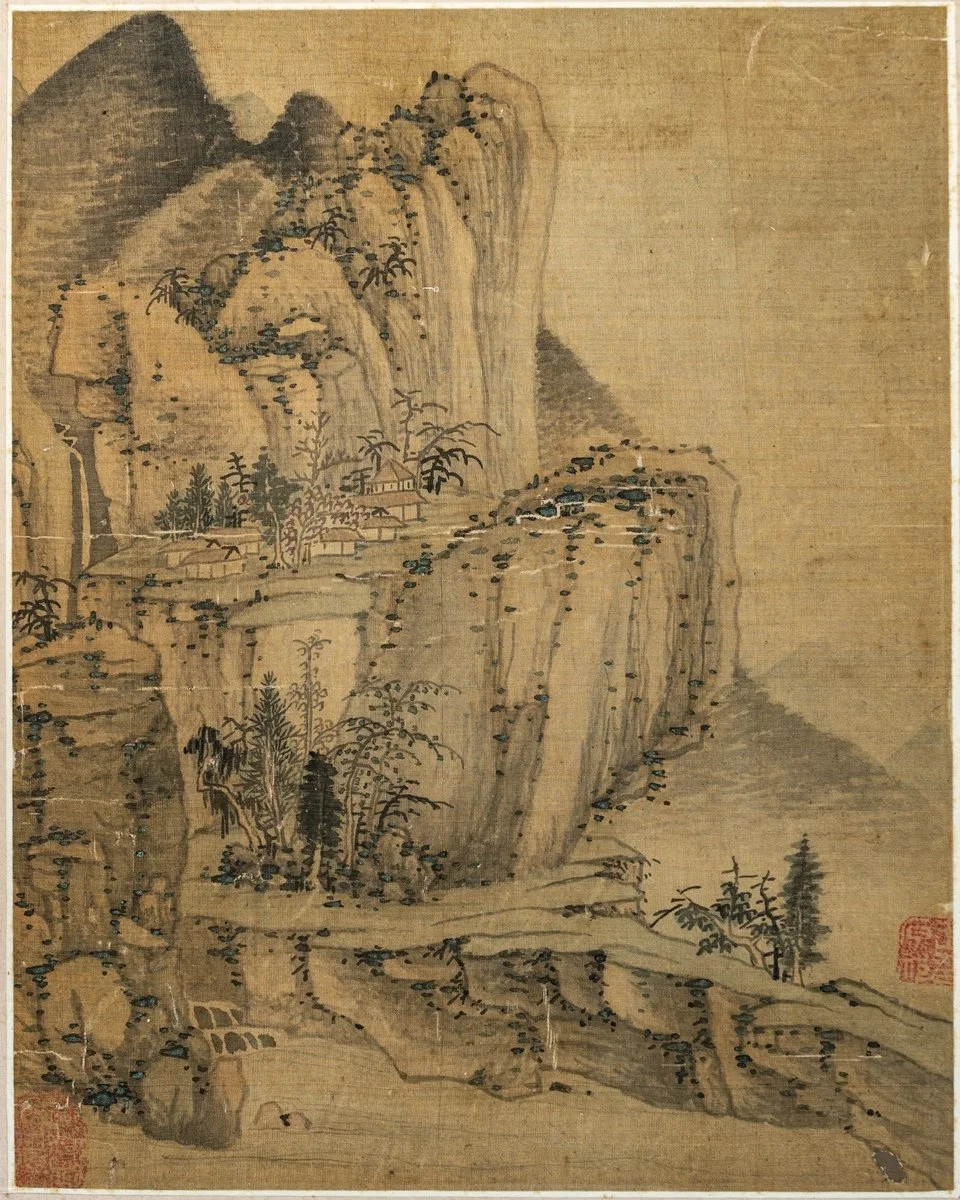About This Artwork
This work by Wang Yuanqi exemplifies the essence of his “Dragon Vein” theory. With firm and deliberate brushwork, the painting centers on a main peak, using folding-ribbon and axe-cut texture strokes layered with ink. Light washes of ochre and indigo evoke the restrained elegance of Huang Gongwang’s “light crimson” style, rather than the heroic vigor of the Song masters. The lake’s blank space balances solidity and void, echoing Dong Qichang’s notion of “using white as black.” The secluded cottages and wooden bridge suggest poetic emptiness, embodying the idea of “seeking marvels within the ordinary.” Free from the melancholic undertones of late Ming loyalist painting, the composition presents a tranquil and orderly landscape. Meandering paths interconnect the scene, illustrating the fusion of literati aesthetics with imperial court sensibilities. Wang’s “blended color and ink” technique transforms tradition with innovation, replacing the sparse clarity of Yuan landscapes with dense textures and dynamic rhythms. Among the “Four Wangs,” he stands out for his philosophical and structural approach, marking the transition of literati landscape painting into imperial visual rhetoric. His style laid the foundation for Qianlong-period academy painting and can be seen as a visual declaration of early Qing cultural consolidation.
• Title: Landscape | 山水
• Year: c. 1700
• Artist: Attributed to Wang Yuanqi | 王原祁(款)
• Medium: Ink and colour on silk | 设色绢本
• Seal: “Wang Yuanqi Yin” | 钤印:「王原祁印」
• Dimensions: 30.5 x 24.5 cm
• Framed Dimensions: 78 x 50.5 x 5 cm
* This is the original, one-of-a-kind artwork created by the artist, not a reproduction or print. It carries the full authenticity and intention of the artist’s hand.
About the Artist
Wang Yuanqi (1642–1715) was a court painter of the Qing dynasty and a leading figure of the "Loudong School." He inherited Dong Qichang’s theory of the “Northern and Southern Schools” and extensively studied the styles of Song and Yuan masters. His brushwork is steady and composed, with refined color tones and a profound sense of rhythm and structure. Wang proposed the theory of the “Dragon Vein,” emphasizing compositional coherence and spatial layering, which became foundational to Qing court painting. Serving in the Imperial Painting Academy, he was commissioned by the Kangxi Emperor to paint Illustrations of the Grand Birthday Celebration, received multiple imperial inscriptions, and became a seminal figure whose influence endured for three centuries of Qing painting.
About This Artwork
This work by Wang Yuanqi exemplifies the essence of his “Dragon Vein” theory. With firm and deliberate brushwork, the painting centers on a main peak, using folding-ribbon and axe-cut texture strokes layered with ink. Light washes of ochre and indigo evoke the restrained elegance of Huang Gongwang’s “light crimson” style, rather than the heroic vigor of the Song masters. The lake’s blank space balances solidity and void, echoing Dong Qichang’s notion of “using white as black.” The secluded cottages and wooden bridge suggest poetic emptiness, embodying the idea of “seeking marvels within the ordinary.” Free from the melancholic undertones of late Ming loyalist painting, the composition presents a tranquil and orderly landscape. Meandering paths interconnect the scene, illustrating the fusion of literati aesthetics with imperial court sensibilities. Wang’s “blended color and ink” technique transforms tradition with innovation, replacing the sparse clarity of Yuan landscapes with dense textures and dynamic rhythms. Among the “Four Wangs,” he stands out for his philosophical and structural approach, marking the transition of literati landscape painting into imperial visual rhetoric. His style laid the foundation for Qianlong-period academy painting and can be seen as a visual declaration of early Qing cultural consolidation.
• Title: Landscape | 山水
• Year: c. 1700
• Artist: Attributed to Wang Yuanqi | 王原祁(款)
• Medium: Ink and colour on silk | 设色绢本
• Seal: “Wang Yuanqi Yin” | 钤印:「王原祁印」
• Dimensions: 30.5 x 24.5 cm
• Framed Dimensions: 78 x 50.5 x 5 cm
* This is the original, one-of-a-kind artwork created by the artist, not a reproduction or print. It carries the full authenticity and intention of the artist’s hand.
About the Artist
Wang Yuanqi (1642–1715) was a court painter of the Qing dynasty and a leading figure of the "Loudong School." He inherited Dong Qichang’s theory of the “Northern and Southern Schools” and extensively studied the styles of Song and Yuan masters. His brushwork is steady and composed, with refined color tones and a profound sense of rhythm and structure. Wang proposed the theory of the “Dragon Vein,” emphasizing compositional coherence and spatial layering, which became foundational to Qing court painting. Serving in the Imperial Painting Academy, he was commissioned by the Kangxi Emperor to paint Illustrations of the Grand Birthday Celebration, received multiple imperial inscriptions, and became a seminal figure whose influence endured for three centuries of Qing painting.

